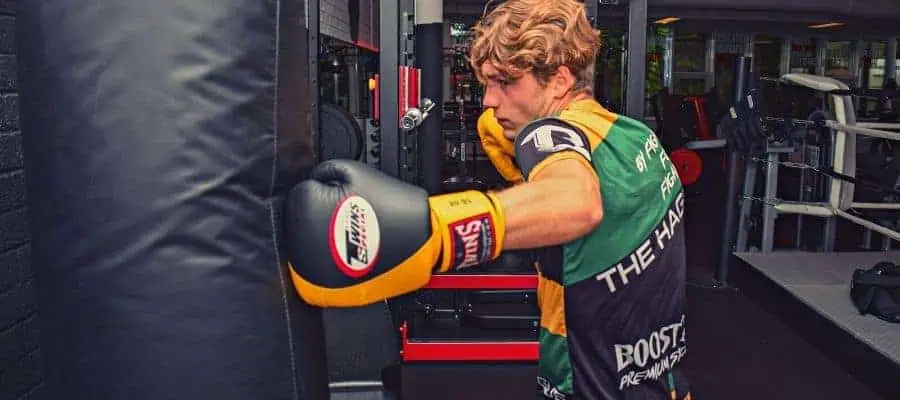A check hook is a regular side punch but with extra footwork. When a fighter executes a check-hook, he makes a side step to the punching arm (moves to the side by 90 degrees) or a bounce to the back. But what are the advantages of this punch, and why should every boxer include it in their skill?
The check hook is very dangerous because it is a defensive punch with the exit from the attack line. It is used as a counter punch when an opponent is attacking. This punch uses the effect of surprise when the opponent is not focused on defense. Because of this, it is a very high chance of knocking the opponent out.
Still, proper technique in punch execution is also essential. As you have already understood, the punch can smash the opponent. The boxer also has to plan the next steps of his attack after a check hook. This is necessary if, for some reason, the check hook does not knock the opponent out. This is why a series of punches will be needed to win the fight.
Check Hook Technique Analysis

Here is the first stage of this technique. The conditional opponent throws a right straight punch. Then he attacks with a straight left to the head. How should you react? First, take a side step to get out of your opponent’s attack line. So, take a sidestep together with a left hook to the head.
You can also add an extra counterpunch to this hook. For example, you can execute a right uppercut after the left hook. Do the step so that the foot turns at an angle of about 90 degrees. The step should be done with the right shoulder turned forward, and the left shoulder pulled back simultaneously.
The goal is to make such a movement that the arm goes alongside the opponent’s body. Also, the leg turns almost perpendicular to another leg. The opponent throws his left hand to your shoulder. Your task is to put your right leg so as not to fall over, i.e., to keep your balance.
Then you have to turn your right shoulder so the left shoulder will be slightly lower. From this position, throw a punch at your opponent. This is where you have to execute a hard counter-punch across his arm. If the opponent is not knocked out by this punch and he keeps standing, you can next step back with your left foot and hit him with a left straight punch.
Next, a combination of punches can be performed. But you must remember that two or three punches are enough on a backward attack. You don’t have to throw a lot of punches. The main thing is to try to get over the opponent’s arm and be on his side.
Counterattack At The Jump

Sometimes you will be in a situation where you can’t escape the opponent’s attack by turning to the side with a punch. In this situation, if you have someplace to go backward, you can use a counterattack in the jump. It’s not a punch on the jump; it’s a punch on a little hop.
You jump on two feet while keeping the fighting stance when executing jumping punches. The idea of this punch is to jump back to escape the attack. After that, do lighting jump forward to break the distance and counterattack the opponent.
At a long distance, do a jump on two legs forward. At a smaller distance, you can punch just with a step forward. Execute the punch and then immediately jump back to the long distance. This way, you secure yourself if the opponent tries to punch you back after your attack. This is the main trick of such punches.
If we talk about a combination of straight and side punches, you can throw a long straight and side punch on the jump. But you must remember that when the opponent is tall or has good movement skills, he will often try to dodge the attack.
How To Improve Your Sidestep?

An excellent exercise to practice stepping backward and sidestepping with a punch. The partner puts her/ his arms forward, hooks them together, and runs forward at the boxer. The boxer moves to the side or turns his body 90 degrees with his legs to escape from his moving partner.
In other words, we let the opponent fall a little bit forward. That way, we’re preparing the situation where we can hit with a step forward and a little bit to the side. Also, you can escape turning with a check hook.
How To Improve Your Hook?

The most helpful exercise for practicing the hook is the punching pads. Pads allow you to give the punch the required angle. As you improve your technique and the power of your punches, you can also use the big pads. They should not be held in the air but with the elbow leaning on the side of the body.
It is also possible to put them down and raise them only for the time needed for punch. This will help avoid tiredness for the one holding these pads. After practicing the punch on the pads, you can improve it even more on the heavy bag.
It is important to remember that you must put all possible mass and force into the punch, and not do it only with your hand. Also, when throwing a hook, there should not be a pre-lift of the elbow. The hand comes from underneath, and the elbow naturally follows the arm’s trajectory.
Conclusion
In summary, always remember that the check hook is a counterpunch that needs to be fast and unexpected. Also, in boxing, you can only tell 100 % each technique will work and which not. That is why always remember to defend yourself during the fight.
If you found this article useful, you may want to save this pin below to your Combat Sports board.

Recent Posts
The topic of professional boxers and marijuana use stirs a vibrant debate in the sporting community. With changing laws and societal attitudes towards cannabis, the question arises: can a pro boxer...
12 Secret Old-School Boxing Exercises (From legendary boxers)
Secret exercises for boxers from the old-school masters. In this article, you will find out 12 unusual exercises that were done by famous boxers from the last century till today. Boxing is closely...
